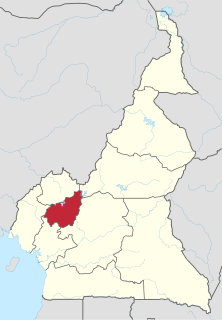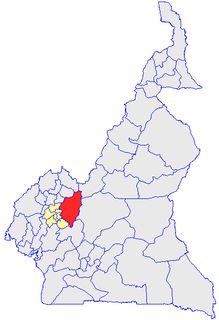
Cameroon, officially the Republic of Cameroon, is a country in Central Africa. It is bordered by Nigeria to the west and north; Chad to the northeast; the Central African Republic to the east; and Equatorial Guinea, Gabon and the Republic of the Congo to the south. Cameroon's coastline lies on the Bight of Biafra, part of the Gulf of Guinea and the Atlantic Ocean. Although Cameroon is not an ECOWAS member state, it is geographically and historically in West Africa with the Southern Cameroons which now form her Northwest and Southwest Regions having a strong West African history. The country is sometimes identified as West African and other times as Central African due to its strategic position at the crossroads between West and Central Africa.

Benue–Congo is a major subdivision of the Niger–Congo language family which covers most of Sub-Saharan Africa. It consists of two main branches:

The Centre Region occupies 69,000 km² of the central plains of the Republic of Cameroon. It is bordered to the north by the Adamawa Region, to the south by the South Region, to the east by the East Region, and to the West by the Littoral and West Regions. It is the second largest of Cameroon's regions in land area. Major ethnic groups include the Bassa, Ewondo, and Vute.
The Cameroon Democratic Union is a political party in Cameroon. It was founded by Adamou Ndam Njoya, a former Minister of National Education under President Ahmadou Ahidjo, on 26 April 1991.

The West Region is 14,000 km² of territory located in the central-western portion of the Republic of Cameroon. It borders the Northwest Region to the northwest, the Adamawa Region to the northeast, the Centre Region to the southeast, the Littoral Region to the southwest, and the Southwest Region to the west. The West Region is the smallest of Cameroon's ten regions in area, yet it has the highest population density.

Bafoussam is the capital and largest city of the West Region of Cameroon, in the Bamboutos Mountains. It is the 3rd most important (financially) city in Cameroon, after Yaounde and Douala. The communauté urbaine of Bafoussam, is a decentralized territorial collectivity. Originally called Urban Commune of Bafoussam, the communauté urbaine of Bafoussam, was born after the Presidential Decree N ° 2008/022 of January 17, 2008 and composed of three communes, namely: the Commune of Bafoussam I, the Commune of Bafoussam II (Baleng) and the Commune of Bafoussam III (Bamougoum).
Fula, also known as Fulani or Fulah, is a Senegambian language spoken as a set of various dialects in a continuum that stretches across some 20 countries in West and Central Africa. Along with other related languages such as Serer and Wolof, it belongs to the Senegambian branch within the Niger–Congo languages, which does not have tones, unlike most other Niger–Congo languages. More broadly, it belongs to the Atlantic geographic grouping within Niger–Congo. It is spoken as a first language by the Fula people from the Senegambia region and Guinea to Cameroon, Nigeria, and Sudan and by related groups such as the Toucouleur people in the Senegal River Valley. It is also spoken as a second language by various peoples in the region, such as the Kirdi of northern Cameroon and northeastern Nigeria.

The Regions of Cameroon are divided into 58 divisions or departments. The divisions are further sub-divided into sub-divisions (arrondissements) and districts. The divisions are listed below, by province.
Ngambay is one of the major languages spoken by Sara people in southwestern Chad, northeastern Cameroon and eastern Nigeria, with about a million native speakers. Ngambay is the most widely spoken of the Sara languages, and is used as a trade language between speakers of other dialects.

The Mbam River is the main tributary of the Sanaga River in Cameroon.
The Kwasio language, also known as Ngumba / Mvumbo, Bujeba, and Gyele / Kola, is a language of Cameroon, spoken in the south along the coast and at the border with Equatorial Guinea by some 70 000 members of the Ngumba, Kwasio, Gyele and Mabi peoples. Many authors view Kwasio and the Gyele/Kola language as distinct. In the Ethnologue, the languages therefore receive different codes: Kwasio has the ISO 639-3 code nmg, while Gyele has the code gyi. The Kwasio, Ngumba, and Mabi are village farmers; the Gyele are nomadic Pygmy hunter-gatherers living in the rain forest.
Iyasa is a Bantu language of Cameroon and Equatorial Guinea by Ndowe coastal fishing people. It is also spoken by Pygmies, perhaps Babongo, in Gabon.
Eton, or Ìtón, is a Bantu language spoken by the Eton people of Cameroon.
Medumba is a Grassfields language of Cameroon. The people who speak it originate from the Nde division of the West Region of the country, with their main settlements in Bangangté, Bakong, Bangoulap, Bahouoc, Bagnoun and Tonga. It is a major Bamileke language, and is located in an area where sacred kingship played a pivotal role in government, justice, and diplomacy. The modern history of the Bamileke area, which was a German colony placed under French trusteeship by the League of Nations in 1919, is closely associated with the nationalist movement of the Union des Populations du Cameroun (UPC), which developed primarily in the coastal hinterland (Bassa) and the western highlands (Bamileke). From 1956 to the late 1960s, this area of Cameroon experienced a period of unrest; this episode continues to shape Bamileke political culture, and has an impact on language identity and the linguistic landscape.
Wandala, also known as Mandara or Mura', is a language in the Chadic branch of the Afro-Asiatic language family, spoken in Cameroon and Nigeria.









